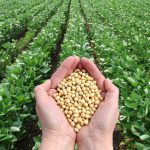
Plants have sophisticated defense systems: They can share proteins, bait and trap pathogens
Tuesday, September 25, 2018 by Ralph Flores
http://www.realsciencenews.com/2018-09-25-plants-have-sophisticated-defense-systems-they-can-share-proteins-bait-and-trap-pathogens.html

New research has revealed that specific plant proteins can identify signals linked to disease-causing agents using “baits” and trap them before they can affect a plant. The study, published in Genome Biology, looked at how “bait genes” are distributed in various wild and domestic grasses, as well as how they respond to protect the plant against a pathogen attack.
Scientists from the Earlham Institute and The Sainsbury Laboratory in Norwich Park, U.K. identified the distribution of these “bait genes” using phylogenetics, that is, the study of how organisms are ancestrally related. These included essential crop plants such as wheat, barley, maize, and rice.
The team focused on nucleotide binding leucine-rich repeat (NLR) proteins in the study. In particular, NLR proteins provide plants with much-needed immunity to fend off rapidly evolving pathogens. Moreover, recent studies have also identified NLR proteins to be responsible for identifying pathogens in flowering plants, with particular regions in the protein (referred to as domain) acting as “baits” that mimic host targets.
As the team studied the genetic history of the plants, they discovered groups that led to novel fusions with plant receptors. They identified this to be NLRs with integrated domains (NLR-IDs), with the most diverse fusions identified in the wheat crop. According to researchers, NLR-IDs have an effect on plant responses, mainly those caused by stress and defending against a pathogen. (Related: Plants “adapt or die” too: Study finds botanical defense mechanisms evolve based on herbivores’ immunity to chemical toxins.)
“If we could understand better how these proteins with these additional ‘integrated’ domains were formed during recent evolution, then there is a good chance that we could engineer genes with specific domains to provide resistance to new types of pathogen attack,” explained lead author Paul Bailey, who also performed the phylogenetic analysis.
Researchers were particularly interested in polyploid bread wheat (Triticum aestivum) for the study because of the size and complexity of its genetic makeup. Aside from having an elevated number of NLRs and NLR-IDs, it also has higher amounts of new integrations. This allowed the team to trace the roots of the NLR-ID. They also evaluated genomes from eight species of grass, with researchers comparing gene similarity between closely related species like wheat and barley, as well as distantly related species such as wheat and maize.
“We were intrigued to find that even between closely-related species, there can be significant variability between the type of fusion events that have occurred, indicating that the process is still active and ongoing in these plants,” added Paul.
The results of the study revealed that NLR-IDs in grass species are able to be integrated into new domains. However, these tend to be distributed unevenly across the phylogeny. One thing that remains unanswered in the study is how the plant identifies new pathogens. According to researchers, this could be closely linked to the development of plant immune receptors and their development. When higher quality genome assemblies become available in the future, this will provide more detailed analysis of NLR-ID formation, they add.
Of the findings, the researchers believe that this will benefit genetic studies that develop disease resistance in farming. “When plants are able to evolve rapidly, they can respond to pathogens working their way around other defenses. Uncovering how plants stay healthy is still a challenge,” lead author Dr. Ksenia Krasilvea concludes of the study. “Together, we uncovered one of the tricks plant use which will help to generate resistant crops.”
Learn even more scientific breakthroughs by following Science.news today.
Sources include:





